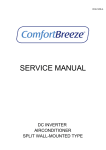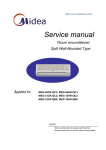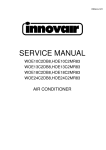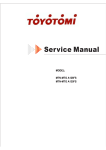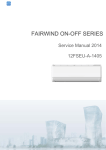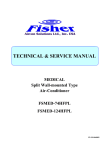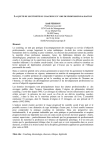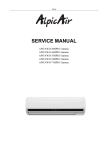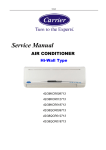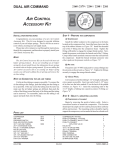Download SERVICE MANUAL
Transcript
9VSEU-1105-A SERVICE MANUAL MIDEA AIRCONDITIONER EUROPE MARKET SPLIT WALL-MOUNTED TYPE 9V ON-OFF SERIES CONTENTS 1. Precaution .................................................................................................................................................... 1 1.1 Safety Precaution ........................................................................................................................1 1.2 Warning .......................................................................................................................................1 2. Function ........................................................................................................................................................ 6 3. Dimension .................................................................................................................................................... 9 3.1 Indoor Unit ...................................................................................................................................9 3.2 Outdoor Unit ..............................................................................................................................10 4. Refrigerant Cycle Diagram ........................................................................................................................ 11 5. Wiring Diagram .......................................................................................................................................... 12 5.1 Indoor Unit .................................................................................................................................12 5.2 Outdoor Unit ..............................................................................................................................13 6. Installation details ..................................................................................................................................... 14 6.1 Wrench torque sheet for installation ..........................................................................................14 6.2 Connecting the cables ...............................................................................................................14 6.3 Pipe length and the elevation ....................................................................................................14 6.4 Air purging with vacuum pump ..................................................................................................15 6.5 Pumping down (Re-installation) ................................................................................................16 6.6 Re-air purging (Re-installation) .................................................................................................17 6.7 Balance refrigerant of the 2-way, 3-way valves .........................................................................18 6.8 Evacuation ................................................................................................................................19 6.9 Gas charging .............................................................................................................................20 7. Operation characteristics ......................................................................................................................... 22 8. Electronic function .................................................................................................................................... 23 8.1 Abbreviation ..............................................................................................................................23 8.2 Display function .........................................................................................................................23 8.3 Main Protection .........................................................................................................................24 8.4 Operation Modes and Functions ...............................................................................................24 9. Troubleshooting......................................................................................................................................... 33 9.1 Indoor Unit Error Display ...........................................................................................................34 9.2 Diagnosis and Solution..............................................................................................................34 1. Precaution 1.1 Safety Precaution To prevent injury to the user or other people and property damage, the following instructions must be followed. Incorrect operation due to ignoring instruction will cause harm or damage. Before service unit, be sure to read this service manual at first. 1.2 Warning Installation Do not use a defective or underrated circuit breaker. Use this appliance on a dedicated circuit. There is risk of fire or electric shock. For electrical work, contact the dealer, seller, a qualified electrician, or an Authorized service center. Do not disassemble or repair the product, there is risk of fire or electric shock. Always ground the product. There is risk of fire or electric shock. Install the panel and the cover of control box securely. There is risk of fire of electric shock. Always install a dedicated circuit and breaker. Improper wiring or installation may cause fore or electric shock. Use the correctly rated breaker of fuse. There is risk of fire or electric shock. Do not modify or extend the power cable. There is risk of fire or electric shock. Do not install, remove, or reinstall the unit by yourself(customer). There is risk of fire, electric shock, explosion, or injury. Be caution when unpacking and installing the product. 1 Sharp edges could cause injury, be especially careful of the case edges and the fins on the condenser and evaporator. For installation, always contact the dealer or an Authorized service center. There is risk of fire, electric shock, explosion, or injury. Do not install the product on a defective installation stand. It may cause injury, accident, or damage to the product. Be sure the installation area does not deteriorate with age. If the base collapses, the air conditioner could fall with it, causing property damage, product failure, and personal injury. Do not let the air conditioner run for a long time when the humidity is very high and a door or a window is left open. Moisture may condense and wet or damage furniture. Take care to ensure that power cable could not be pulled out or damaged during operation. There is risk of fire or electric shock. Do not place anything on the power cable. There is risk of fire or electric shock. Do not plug or unplug the power supply plug during operation. There is risk of fire or electric shock. Do not touch (operation) the product with wet hands. There is risk of fire or electric shock. Do not place a heater or other appliance near the power cable. There is risk of fire and electric shock. Do not allow water to run into electric parts. It may cause fire, failure of the product, or electric shock. Do not store or use flammable gas or combustible near the product. There is risk of fire or failure of product. Do not use the product in a tightly closed space for a long time. Oxygen deficiency could occur. When flammable gas leaks, turn off the gas and open a window for ventilation before turn the product on. 2 Do not use the telephone or turn switches on or off. There is risk of explosion or fire. If strange sounds, or small or smoke comes from product. Turn the breaker off or disconnect the power supply cable. There is risk of electric shock or fire. Stop operation and close the window in storm or hurricane. If possible, remove the product from the window before the hurricane arrives. There is risk of property damage, failure of product, or electric shock. Do not open the inlet grill of the product during operation. (Do not touch the electrostatic filter, if the unit is so equipped.) There is risk of physical injury, electric shock, or product failure. When the product is soaked (flooded or submerged), contact an Authorized service center. There is risk of fire or electric shock. Be caution that water could not enter the product. There is risk of fire, electric shock, or product damage. Ventilate the product from time to time when operating it together with a stove, etc. There is risk of fire or electric shock. Turn the main power off when cleaning or maintaining the product. There is risk of electric shock. When the product is not be used for a long time, disconnect the power supply plug or turn off the breaker. There is risk of product damage or failure, or unintended operation. Take care to ensure that nobody could step on or fall onto the outdoor unit. This could result in personal injury and product damage. CAUTION Always check for gas (refrigerant) leakage after installation or repair of product. Low refrigerant levels may cause failure of product. Install the drain hose to ensure that water is drained away properly. 3 A bad connection may cause water leakage. Keep level even when installing the product. To avoid vibration of water leakage. Do not install the product where the noise or hot air from the outdoor unit could damage the neighborhoods. It may cause a problem for your neighbors. Use two or more people to lift and transport the product. Avoid personal injury. Do not install the product where it will be exposed to sea wind (salt spray) directly. It may cause corrosion on the product. Corrosion, particularly on the condenser and evaporator fins, could cause product malfunction or inefficient operation. Operational Do not expose the skin directly to cool air for long periods of time. (Do not sit in the draft). This could harm to your health. Do not use the product for special purposes, such as preserving foods, works of art, etc. It is a consumer air conditioner, not a precision refrigerant system. There is risk of damage or loss of property. Do not block the inlet or outlet of air flow. It may cause product failure. Use a soft cloth to clean. Do not use harsh detergents, solvents, etc. There is risk of fire, electric shock, or damage to the plastic parts of the product. Do not touch the metal parts of the product when removing the air filter. They are very sharp. There is risk of personal injury. Do not step on or put anything on the product. (outdoor units) There is risk of personal injury and failure of product. Always insert the filter securely. Clean the filter every two weeks or more often if necessary. 4 A dirty filter reduces the efficiency of the air conditioner and could cause product malfunction or damage. Do not insert hands or other object through air inlet or outlet while the product is operated. There are sharp and moving parts that could cause personal injury. Do not drink the water drained from the product. It is not sanitary could cause serious health issues. Use a firm stool or ladder when cleaning or maintaining the product. Be careful and avoid personal injury. Replace the all batteries in the remote control with new ones of the same type. Do not mix old and mew batteries or different types of batteries. There is risk of fire or explosion. Do not recharge or disassemble the batteries. Do not dispose of batteries in a fire. They may burn of explode. If the liquid from the batteries gets onto your skin or clothes, wash it well with clean water. Do not use the remote of the batteries have leaked. The chemical in batteries could cause burns or other health hazards 5 2. Function Model Names of Indoor/Outdoor Unit Cooling only: Series On-Off Capacity Indoor units Outdoor units 7k MS9V-07HRN1-QC2 MOK1-07HN1-QC2 6 Indoor unit Operation ON/OF by remote controller Auto Restart Function When the power supply is interrupted and then restore, the air conditioners automatically restore the previous function setting Sensing by room temperature Room temperature sensor. Pipe temperature sensor. Room temperature control Maintain the room temperature in accordance with the setting temperature. Starting temperature control Indoor fan is delayed for 5 sec at the starting Time Delay Safety control Self-cleaning Restarting is for approx. 3 minutes.. Indoor fan speed control Follow me High, med, low, auto. Two-direction air vane The unit will decide the louver direction according to operation mode. Timer function Sleep mode auto control Self-diag. function The fan is turn to low speed (cooling). Independent dehumidification Flexible wiring connection The function is usually used in rainy days in springtime or damp areas. Air flow Direction control Ionizer (optional) The louver can be set at the desired position or swing up and down automatically Auto mode Indoor golden fin (optional) The mode can be change by the room temperature. Easy clean panel Temp. Compensation 7 Outdoor unit Power relay control The unit has 3 min delay between continuously ON/OFF operations. Low noise air flow system Bird tail propeller fan makes the outdoor unit run more quietly. Anti-rust cabinet Made from electrolytic zinc steel sheet and anti-rust coated components. Valve protection cover It protects the valves and prevents water from dripping. 8 3. Dimension 3.1 Indoor Unit Dimension Model 7K 9 W H D 850 290 165 3.2 Outdoor Unit Dimension Model 7K W D H W1 A B 685 260 430 742 460 276 10 4. Refrigerant Cycle Diagram 11 5. Wiring Diagram 5.1 Indoor Unit MS9V-07HRN1-QC2 12 5.2 Outdoor Unit MOK1-07HN1-QC2 13 6. Installation details 6.1 Wrench torque sheet for installation Outside diameter Torque Additional tightening torque mm inch N·cm N·cm Ф6.35 1/4 1500 1600 (153kgf.cm) (163kgf.cm) Ф9.52 3/8 2500 2600 (255kgf.cm) (265kgf.cm) 6.2 Connecting the cables The power cord of connect should be selected according to the following specifications sheet. Rated current of appliance Nominal cross-sectional area (mm²) >3 and ≤6 0.75 >6 and ≤10 1.0 >10 and ≤16 1.5 >16 and ≤25 2.5 6.3 Pipe length and the elevation Pipe size Standard Max. Max. Additional length Elevation Length refrigerant (m) B (m) A (m) (g/m) 5 8 20 20 Capacity Btu/h 7K Gas 3/8’’ (Ф9.52) Liquid 1/4’’ (Ф6.35) Caution: 14 Capacity test is based on standard length and maximum allowance length is based on reliability. Oil trap should be installed per 5-7 meters. 6.4 Air purging with vacuum pump Air and moisture in the refrigerant system have undesirable effects as below: ● Pressure in the system rises. ● Operating current rises. ● Cooling efficiency drops. ● Moisture in the refrigerant circuit may freeze and block capillary tubing. ● Water may lead to corrosion of parts in the refrigerant system. Therefore, the indoor units and the pipes between indoor and outdoor units must be leak tested and evacuated to remove gas and moisture from the system. Air purging with vacuum pump (Indoor unit) (Outdoor unit) (Liquid side) Two-way valve Close (Gas side) Three-way valve Manifold valve Compound meter Pressure gauge -76cmHg Lo Handle Lo Charge hose Close Hi Handle Hi Charge hose Vacuum pump adaptor Vacuum pump 1. Completely tighten the flare nuts of the indoor and outdoor units, connect the manifold valve charge. 2. Connect the charge hose connection to the vacuum pump. 3. Fully open the handle Lo of the manifold valve. 4. Operate the vacuum pump to evacuate. After starting evacuation, slightly loose the flare nut of the Lo valve on the gas pipe side and check the air is entering. (Operation noise of the vacuum pump changes and a compound meter indicates 0 stead of minutes) 5. After the evacuation is complete, fully close the handle Lo valve of the manifold valve and stop the operation of the vacuum pump. Make evacuation for 15 minutes or more and check the compound meter indicates -76cmHg. 6. Turn the stem of the Hi valve about 45°counterclockwise for 6 or 7seconds after the gas coming out, then tighten the flare nut again. Make sure the pressure display in the pressure indicator is a 15 little higher than the atmosphere pressure. 7. Remove the charge hose from the Lo pressure charge hose. 8. Fully open the Hi and Lo packed valve. 9. Securely tighten the cap of the packed valve. Gas leak check Soap water method Apply soap water or a liquid neutral detergent on the indoor unit connections or outdoor unit connections by a soft brush to check for leakage of the connecting points of the piping. If bubbles come out, the pipes have leakage. 6.5 Pumping down (Re-installation) Produce 1. Confirm that both the 2-way and 3-way valves are set to the opened position. Remove the valve stem caps and confirm that the valve stems are in the opened position. Be sure to use a hexagonal wrench to operate the valve stems. 2. Operate the unit for 10 to 15 minutes. 3. Stop operation and wait for 3 minutes, then connect the charge set to the service port of the 3-way valve. Connect the charge hose with the push pin to the gas service port. 16 5. Air purging of the charge hose. Open the low-pressure valve on the charge set slightly to purge air from the charge hose. 6. Set the 2-way valve to the close position. 7. Operate the air conditioner at the cooling cycle and stop it when the gauge indicates 0.1MPa. 8. Immediately set the 3-way valve to the closed position. Do this quickly so that the gauge ends up indicating 0.3 to 0.5Mpa. Disconnect the charge set, and amount the 2-way and 3-way valve’s stem nuts and service port caps. Use a torque wrench to tighten the service port cap. Be sure to check for gas leakage. 6.6 Re-air purging (Re-installation) Procedure: 1. Confirm that both the 2-way and 3-way valves are set to the closed position. 2. Connect the charge set and a charging cylinder to the service port of the 3-way valve. Leave the valve on the charging cylinder closed. 3. Air purging. 17 Open the valves on the charging cylinder and the charge set. Purge the air by loosening the flare nut on the 2-way valve approximately 45’ for 3 seconds then closing it for 1 minute; repeat 3 times. After purging the air, use a torque wrench to tighten the flare nut to on the 2-way valve. 4. Check the gas leakage. Check the flare connections for gas leakage. 5. Discharge the refrigerant. Close the valve on the charging cylinder and discharge the refrigerant until the gauge indicates 0.3 to 0.5 Mpa. 6. Disconnect the charge set and the charging cylinder, and set the 2-way and 3-way valves to the open position. Be sure to use a hexagonal wrench to operate the valve stems. 7. Mount the valve stems nuts and the service port cap. Be sure to use a torque wrench to tighten the service port cap to a torque 18N.m. Be sure to check the gas leakage. 6.7 Balance refrigerant of the 2-way, 3-way valves Procedure: 1. Confirm that both the 2-way and 3-way valves are set to the open position. 18 2. Connect the charge set to the 3-way valve’s service port. Leave the valve on the charge set closed. Connect the charge hose with the push pin to the service port. 3. Open the valves (Low side) on the charge set and discharge the refrigerant until the gauge indicates 0.05 to 0.1Mpa. If there is no air in the refrigeration cycle the pressure when the air conditioner is not running is higher than 0.1Mpa, discharge the refrigerant until the gauge indicates 0.05 to 0.1 Mpa. In this case, it will not be necessary to apply an evacuation. Discharge the refrigeration gradually; if it is discharged too suddenly, the refrigeration oil will be discharged. 6.8 Evacuation Procedure: 1. Connect the vacuum pump to the charge set’s centre hose. 2. Evacuation for approximately one hour. Confirm that the gauge needle has moved toward -0.1 Mpa (-76 cmHg) [vacuum of 4 mmHg or less]. 3. Close the valve (Low side) on the charge set, turn off the vacuum pump, and confirm that the gauge needle does not move (approximately 5 minutes after turning off the vacuum pump). 19 4. Disconnect the charge hose from the vacuum pump. Vacuum pump oil, if the vacuum pump oil becomes dirty or depleted, replenish as needle. 6.9 Gas charging Procedure: 1. Connect the charge hose to the charging cylinder. Connect the charge hose which you disconnected from the vacuum pump to the valve at the bottom of the cylinder. If the refrigerant is R410A, make the cylinder bottom up to ensure liquid charge. 2. Purge the air from the charge hose. Open the valve at the bottom of the cylinder and press the check valve on the charge set to purge the air (be careful of the liquid refrigerant). 3. Open the valves (Low side) on the charge set and charge the system with liquid refrigerant. If the system cannot be charge with the specified amount of refrigerant, if can be charged with a little at a time (approximately 150g each time0 while operating the air conditioner in the cooling cycle; however, one time is not sufficient, wait approximately 1 minute and then repeat the procedure.(pumping down-pin). 4. Immediately disconnect the charge hose from the 3-way valve’s service port. Stopping partway will allow the refrigerant to be discharged. 20 If the system has been charged with liquid refrigerant while operating the air conditioner, turn off the air conditioner before disconnecting the hose. 5. Mounted the valve stem caps and the service port Use torque wrench to tighten the service port cap to a torque of 18N.m. Be sure to check for gas leakage. 21 7. Operation characteristics Mode Cooling operation Drying operation Temperature Room temperature 17 ~32 18 ~43 Outdoor temperature 10℃~32℃ (<21000Btu/h models) 17℃~32℃ (≥21000Btu/h models) 11℃~43℃ (<21000Btu/h models) (-5 ~43 :For the models with low temperature cooling system) 18℃~43℃ (≥21000Btu/h models) (21 ~52 :For special tropical models) 21℃~52℃ (For special tropical models) CAUTION: 1. If air conditioner is used outside of the above conditions, certain safety protection features may come into operation and cause the unit to function abnormally. 2. Room relative humidity less than 80%. If the air conditioner operates in excess of this figure, the surface of the air conditioner may attract condensation. Please sets the vertical air flow louver to its maximum angle (vertically to the floor), and set HIGH fan mode. 3. Optimum performance will be achieved within this operating temperature. 22 8. Electronic function 8.1 Abbreviation T1: Indoor ambient temperature T2: Pipe temperature of indoor heat exchanger Ts: Set temperature 8.2 Display function 8.2.1 Icon explanation on indoor display board: OPERATION indication lamp: This lamp illuminates when the air conditioner is in operation. AUTO indication lamp: Lights up during the Auto operation. Timer indicator Lights up during Timer operation Ion indication lamp(optional function): Lights up when Clean Air feature is activated and Ionizer can generate abundant anions to fill the room with refreshing and natural air. DEFROST indication lamp (For cooling & heating models only): Lights up when the air conditioner starts defrosting automatically or when the warm air control feature is activated in heating operation. TURBO indication lamp: Lights up only when select TURBO function on cooling operation or on Auto cooling operation. 8.2.2 LED display control function. Pressing “LED display” button on remote controller will turn off all displays on indoor unit, while pressing once again, all displays will resume. 23 8.3 Main Protection 8.3.1 Time Delay at restart for compressor. 8.3.2 Current protection The following chart shows the protection if the current was too high. While IRestore =4.5A, IFan = 5.5A , I5Min = 6.5A, I5Sec =7.5A for 7K model; 8.3.3 Fan Speed is out of control. When indoor fan speed is too low (lower than 300RPM for 50 seconds), the unit stops and LED displays failure 8.4 Operation Modes and Functions 8.4.1 Fan only mode. (1) Outdoor fan and compressor stop. (2) Temperature setting function is disabled, and no setting temperature is display. (3) Indoor fan can be set to high/med/low/auto. (4) The louver operates the same as in cooling mode. (5) Auto fan: 8.4.2 Cooling Mode 24 8.4.2.1 Compressor and outdoor fan control The action of the compressor and the outdoor fan are submitted to the following rule: 8.4.2.2 Indoor fan running rules In cooling mode, indoor fan runs all the time and the speed can be selected in high, medium, low and auto speed. Auto fan in cooling mode acts as follow: 8.4.2.3 Evaporator low temperature T2 protection. When T2<TE5 continuous for 5 min, the compressor and outdoor fan will stop and restart until T2>TE6. While TE5 = 4℃ ,TE6 = 10℃ for 7K model 8.4.3 Heating Mode 8.4.3.1 Compressor running rules: For 7K model, the compressor will follow the below rules once the compressor starts up: When indoor room temp.T1 is higher than Tj, the compressor and outdoor fan will shut off. When T1 is 25 lower than Tk, the compressor and outdoor fan will start up. Tj=Ts+Tc Tk=Ts+Tc-1. Tc=1 for 7k model . 8.4.3.2 Outdoor fan running rules: The outdoor units have single fan speed. The outdoor fan will run following the compressor except when AC is in evaporator high temp.protection in heating mode , condenser high temp.protection in cooling mode ,defrosting mode and the current protection. 8.4.3.3 Indoor fan running rules: For 7K model, when the compressor is on, the indoor fan can be set to high/med/low/auto. And the anti-cold wind function has the priority. Anti-cold wind function: When evaporator coil temp.T2 is getting higher, T2>TE2, the indoor fan will run at setting speed. TE1<T2<TE2, the indoor fan will run at low speed. When T2 is getting lower, TE4<T2<TE3,the indoor fan will run at low speed. T2<TE4, the indoor fan will shut off. While TE1=28 ,TE2=32 ,TE3=30 ,TE4=26 for 7k model. Auto fan action: 26 When T1-Ts>2 ,the indoor fan will run at low speed. When T1-Ts≤0 , the indoor fan will run at medium speed. 8.4.3.4 Defrosting mode: Condition of defrosting: AC will enter defrosting mode if any of the following items is satisfied. (1) Both A and B are satisfied A: The compressor keeps running for 40 minutes. B: The evaporator coil temp.T2-Indoor room temp.T1 meets the below table. T2-T1 High speed <THDEFROST Medium speed <TMDEFROST Low speed <TLDEFROST Breeze/off No need to compare the T2 and T1 THDEFROST=14℃, TMDEFROST=15℃, TLDEFROST=16℃ for 7k model. (2) After the last defrosting, the time that the outdoor fan is off but the compressor is on in high T2 protection cumulates up to 90 minutes. Condition of ending defrosting: If any one of the following items is satisfied, the defrosting will terminate and the machine will turn to normal heating mode. (1) The defrosting time is reached to the setting value. (2) The compressor current reaches or overs IDEFROST for 7 seconds. IDEFROST=3.0A for 7k model. Defrosting action: 27 About the setting defrosting time: (1) Condition 1 of defrosting; If case B happens before case A and lasts till case A happens, the setting defrosting time is 10 minutes.Otherwise the defrosting time is 7.5 minutes. (2) Condition 2 of defrosting. The defrosting time is 10 minutes. (3) No matter what condition of defrosting is, if the defrosting time keeps 7.5 minutes for 3 times, it will be 10 minutes in the 4th defrosting. 8.4.3.5 High evaporator coil temp.T2 protection: While TE7=60℃,TE8=53℃,TE9=50℃ for 7k model, 8.4.4 Auto-mode This mode can be chosen by remote controller and the setting temperature can be changed between 17~30 . In auto mode, the machine will choose cooling or fan-only mode according to the difference between T1 and Ts. 28 T1-Ts Running mode T1-Ts>2℃ Cooling T1-Ts<-1℃ Fan-only AC will run in auto mode in the below cases: (1) Press the forced auto button. (2) If AC is off. It will run in auto mode when timer on function is active. (3) After setting the mode, AC will run in auto mode if the compressor keeps not running for 15 minutes. 8.4.5 Dehumidify mode 8.4.5.1 Indoor fan speed is depended on compressor, compressor starts, indoor fan in low speed, compressor stops, indoor fan in breeze speed. 8.4.5.2 The action of outdoor fan and compressor are the same is according to the room temperature and set temperature. NO Temperature Compressor and outdoor fan actions ON 1 6min T1 ≥ TS+2 Low speed Alternated action OFF 4min ON 2 Breeze speed 5min Low speed Alternated action TS ≤T1<TS+2 OFF 5min 3 T1<TS Indoor fan actions ON 4min Breeze speed Alternated action OFF 6min Low speed Breeze speed 8.4.5.3 If the room temperature decreased to lower than 10℃, the compressor and outdoor fan will stop, indoor fan in breeze speed. If the room temperature raised to higher than 13℃, recover the dehumidify mode. 8.4.6 Forced operation function 8.4.6.1 Enter forced operation function: Pressing the touch button once, the machine will transfer into forced auto mode, if pressing the button once again, the machine will turn into forced cooling mode, the third pressing will stop the unit, and the forth pressing is the start of the cycle of forced auto mode, forced cooling mode and stop. Refer the following chart: 29 8.4.6.2 In forced operation mode, all general protections and remote control are valid. 8.4.6.3 Operation rules: Forced cooling mode: The indoor fan will work in low speed, compressor and outdoor fan open unconditionally, after 30min, the unit will transfer into dehumidify mode. All the protections are valid during forced cooling mode. Forced auto mode: The action of forced auto mode is the same as normal auto mode with 24 setting temperature. 8.4.7 Timer function 8.4.7.1 Timing range is 24 hours, and the minimum resolution is 15 minutes. 8.4.7.2 Timer on. After turning off, the machine will turn on automatically when reaching the setting time. 8.4.7.3 Timer off. After turning on, the machine will turn off automatically when reaching the setting time. 8.4.7.4 Timer on/off. After turning off, the machine will turn on automatically when reaching the setting “on” time, and then turn off automatically when reaching the setting “off” time. 8.4.7.5 Timer off/on. After turning on, the machine will turn off automatically when reaching the setting “off” time, and then turn on automatically when reaching the setting “on” time. 8.4.7.6 The setting time is relative time. 8.4.7.7 The tolerance of timer is 1 minute per hour. 8.4.8 Sleep function mode 8.4.8.1 Operation time in sleep mode is 7 hours. After 7 hours the AC quits this mode and turns off. 8.4.8.2. Operation process in sleep mode is as follow: After pressing ECONOMIC or SLEEP button on controller, the machine will turn into sleep mode. When cooling, the setting temperature rises 1 (be lower than 30 ) every one hour, 2 hours later the setting temperature stops rising and indoor fan is fixed as low speed. 8.4.8.3 Timer setting is available 30 8.4.8.4 When user uses timer off function in sleep mode (or sleep function in timer off mode), if the timing is less than 7 hours, sleep function will be cancelled when reaching the setting time. If the timing is more than 7 hours, the machine will not stop until reaches the setting time in sleep mode. 8.4.9 Auto-Restart function The indoor unit is equipped with auto-restart function, which is carried out through an auto-restart module. In case of a sudden power failure, the module memorizes the setting conditions before the power failure. The unit will resume the previous operation setting (not including Swing function) automatically after 3 minutes when power returns. If the memorization condition is forced cooling mode, the unit will run in cooling mode for 30 minutes and turn to auto mode as 24 setting temp. If A/C is off before power off and A/C is required to start up now, the compressor will have 1 minutes delay when power on. Other conditions, the compressor will have 3 minutes delay when restarts. 8.4.10 Vertical louver control function (optional) Total four type operations for vertical louver control function: original orientation, orientation, vane adjustment and horizontal swing. 8.4.9.1 Original orientation means when power on, the louver will turn to the datum mark. This action has the highest priority. The other action of vertical louver can’t act until the original orientation action stopped. 8.4.9.2 Orientation means after the original orientation action, the louver turn the middle position of upper limit position and lower limit position. 8.4.9.3 Vane adjustment, pressing the control button on the remote controller to make the vertical louver turn left and right. Each pressing, the louver will turn 6℃. If pressing the button during the original orientation, the louver will only turn 6℃ after the original orientation action stopped regardless the pressing time. No action when the unit is stopped. 8.4.9.4 Horizontal swing means the louver can auto swing horizontally in the allowable range if pressing the button on the remote controller. Pressing once, the louver starts movement, the second pressing is to stop the moving. If indoor fan stopped, the horizontal swing is invalid. 8.4.11 Ionizer/Plasma dust collector function (optional) 31 The indoor unit is equipped with Ionizer, which is controlled by the CLEAN AIR button on the remote controller. When the unit is turned on, press the CLEAN AIR button to activate the function. Press it again to stop the function. During the time when Ionizer being controlled by remote controller, Ionizer will be turned off automatically, if indoor fan stops running due to malfunctions or anti-cold-wind. When indoor fan restarts after malfunctions being eliminated and anti-cold-wind being released, Ionizer will be available again. 32 9. Troubleshooting Safety Because of capacitors in PCB and relative circuit in outdoor unit, even shut down the power supply. Electricity power still are kept in capacitors, do not forget to discharge the electricity power in capacitor. Electrolytic Capacitors (HIGH VOLTAGE! CAUTION!) Bulb (25-40W) 33 9.1 Indoor Unit Error Display Display LED STATUS E1 EEPROM error E2 Zero-Crossing Error E3 Indoor fan speed out of control E4 Over current protection of the compressor occurs 4 times E5 Open or short circuit of Room temperature sensor E6 Evaporator temperature sensor open or short circuit 9.2 Diagnosis and Solution 9.2.1 E1 (EEPROM parameter error) error diagnosis and solution Shut off the power supply and turn on it 5s later Replace indoor PCB The problem comes out again NO Is the EEPROM chip plugged in indoor PCB well? Replace the main PCB of indoor unit 34 Correct the connection 9.2.2 E2 (Zero-Crossing Error) Zero-crossing error Unplug the power cord and plug it after 2 seconds The problem remains YES Replace the main PCB 35 9.2.3 E3(indoor fan speed out of control) diagnosis Shut off the power supply and turn on it 5s later The unit does not work normally Turn off the unit, rotate the cross fan. Does it rotate freely? NO Disassemble the connection between fan and motor, check if the bearing is normal. If not, change the bearing. If yes, follow the below step. YES Is the indoor fan motor connector and connection good? YES Check the voltage between the red and black wires of motor power input .Is it in range of AC90-160V? YES NO Replace the indoor PCB 36 Replace the fan motor 9.2.4 E4 (Over current protection of the compressor occurs 4 times) Current protection Check if the voltage of power supply is too low No ↓ yes → The power supply is problematic Check if the operation condition is normal, especially the outdoor unit? → → No ↓ Repair the power supply correct the operation condition yes Disconnect with the power and replace the main PCB ↓ Turn on the units and check if the problem remains yes → Check if the compressor is normal ? → Check if the capillary is blocked → No There is some mixed inside the refrigerant system yes → Replace the comprssor Replace the capillary Evacuate the refrigerant system and recharge gas 9.2.5 E5/E6 (Open or short circuit of temperature sensor) diagnosis and solution. Check the connections between the sensors and the PCB. Are the connections good? YES Replace the sensor and check if the errors happen again? YES 37 Replace outdoor PCB








































